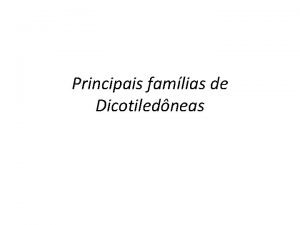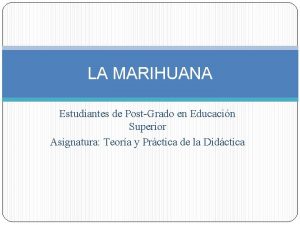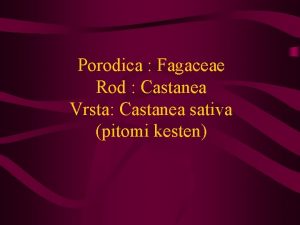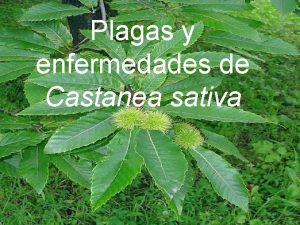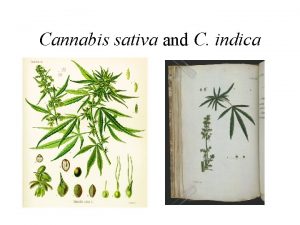Phenotypic Variation of Castanea sativa Mill ecotypes in







- Slides: 7

Phenotypic Variation of Castanea sativa Mill. ecotypes in northern Morocco based on multivariate analysis of leaf Morphometrics TOUJGANI Ihssane(1)*, ELFATEHI Salama(1, 2), ATER Mohammed(1) and HMIMSA Younes(1, 2). Bio-agrodiversity team, Laboratory of applied botany; Department of Biology, Faculty of Science; Abdelmalek Essaâdi University; Tetouan, Morocco. 2 Department of Life Sciences, Polydisciplinary Faculty; Abdelmalek Essaadi University; Larache, Morocco. * Corresponding author: ihssanetoujgani@gmail. com 1 1

Abstract: For decades, local and traditional species have been neglected and replaced by industrial and improved species. Sweet chestnut ‘Castanea sativa MILL. ’, found in a small area in northern Morocco, is no exception. Indeed, Moroccan ecotypes are neither classified nor characterized. This study aims to evaluate the local genetic resources of Castanea sativa MILL. via multivariate analysis of morphometric parameters of leaves. The study involved 6200 leaves from 31 villages in 3 regions; 10 trees/village and 20 leaves/tree were sampled. Then eight morphometric parameters were analyzed: lamina length (LL), lamina width (LW), petiole length (PL), distance from the base of the leaf to the widest point of the leaf (DBW), surface (S), perimeter (P), and ratios LL/LW and LL/DBW. Analysis of the descriptive statistics within and between ecotypes initially showed a large variation in the ten parameters studied. This finding was supported by analysis of variance (ANOVA) which revealed a very highly significant difference (P <0. 0001) for all parameters. Indeed, the analysis of agglomerative hierarchical clustering (AHC) made it possible to group the studied populations into 3 distinct groups based on the surface. Overall, the high level of variability in leaf morphometric parameters indicates that the region is an important center of genetic diversity which assessment is crucial for the implementation of conservation and enhancement strategies for this heritage. Keywords: Castanea sativa MILL. ; local ecotypes; phenotypic variability; morphometric analysis; conservation. 2

Results Analysis of variability The study used the morphometric parameters of 6, 200 leaves to analyze the variability of Moroccan chestnut ecotypes. The results obtained confirm that the leaves morphological traits are very variable. The highest coefficient of variation was observed for the surface (S ). In contrast, the least variable parameter was the shape ratio LL / LW. Table 1. Morphometric parameters studied for the leaf in the 7 watersheds. Watersheds Oued Laou Tamernout Tamrabet Aouchtam Azla Oued Lakhmiss Haouz Parameters S(cm 2) P(cm) PL(cm) LW(cm) Mean SD* CV** (%) Mean SD* CV** (%) 88, 76 24, 81 28, 54 84, 54 29, 70 25, 58 91, 42 32, 22 15, 45 88, 95 32, 22 22, 06 74, 35 30, 99 34, 35 79, 82 20, 12 25, 43 84, 34 21, 23 25, 17 41, 65 5, 53 13, 28 40, 06 6, 79 13, 98 41, 56 7, 20 7, 68 40, 34 8, 29 12, 65 39, 68 8, 66 19, 03 38, 73 5, 20 13, 24 39, 64 4, 83 12, 18 2, 04 0, 38 19, 77 2, 28 0, 41 10, 23 1, 8 0, 73 14, 24 2, 05 0, 40 8, 97 2, 43 0, 65 20, 57 2, 17 0, 37 18, 03 2, 21 0, 33 14, 82 18, 31 2, 56 13, 99 17, 65 3, 35 14, 72 18, 11 3, 42 8, 73 17, 35 4, 27 13, 22 17, 73 4, 17 20, 26 16, 84 2, 50 14, 7 17, 53 2, 24 12, 76 7, 16 1, 26 18, 29 6, 97 1, 33 12, 88 7, 48 1, 58 9, 05 7, 45 1, 36 9, 39 6, 31 1, 39 16, 73 7 0, 96 14, 4 7, 20 1, 09 15, 21 DBW(cm ) 8, 82 1, 51 16, 15 8, 97 2, 25 16, 5 9, 1 2, 09 13, 17 8, 85 2, 42 16, 2 8, 26 2, 11 22, 07 8, 28 1, 48 17, 64 9, 03 1, 30 14, 41 LL/LW LL/DB W 2, 61 0, 40 15, 33 2, 49 0, 38 33, 08 2, 61 0, 54 6, 33 2, 32 0, 42 17, 87 2, 88 0, 68 23, 58 2, 45 0, 32 13, 03 2, 47 0, 26 10, 73 2, 16 0, 21 9, 51 2, 14 1, 17 11, 08 2, 22 0, 64 28, 92 1, 98 0, 20 10, 27 2, 17 0, 19 8, 84 2, 10 0, 20 9, 33 1, 97 0, 11 5, 71 3

Results Analysis of variability The analysis of variance (ANOVA) for the studied morphometric parameters at the leaf level showed a very highly significant variation (P<0, 0001) for all studied parameters. These results reflect the morphological diversity between the individuals that compose the seven watersheds. Table 2. Analysis of variance (ANOVA) of the studied morphometric parameters of the leaves in the ecotypes of Castanea sativa Mill. Parameters S P PL LL LW DBW LL/LW LL/DBW F 31, 55 29, 72 16, 799 29, 49 37, 32 32, 62 28, 91 16. 34 Pr > F < 0, 0001**** < 0, 0001**** The comparison of the means of the leaves morphometric parameters by Student Newman and Keuls (SNK) test at the 5% threshold (Table 3), revealed 5 modes of grouping between the 7 watersheds. Table 3. Comparison of the means of the leaves studied morphometric parameters in chestnut ecotypes by Student Newman Keuls test (SNK). Watersheds S P PL LL LW DBW LL/LW LL/DBW Tamrabet A A A A Oued Laou B B B A B B Tamernount B C C C B A B C Aouchtam B D C D B A C D Azla C E D E C A C E Haouz D F E F D B C F Oued Lakhmiss E G F G E B D F

Results Correlation analysis The analysis of the correlations between the studied parameters showed that there are links between them, which explains the very strong correlations. Agglomerative hierarchical clustering analysis (AHC) Dendrogramme 160 The topology of the dendrogram clearly shows the existence of three large groups relating to the parameters studied at the leaf level. The most similar watersheds are Tamernout and Smir on one side and Oued Laou and Aouchtem on the other one. 140 120 Dissimilarité 100 80 60 40 20 0 Tamrabet Oued Laou Aouchtam Azla Oued Lakhmiss Tamernout Smir Figure 1. Grouping dendrogram of studied ecotypes based on leaf parameters.

Conclusion This study is a first contribution to the knowledge of the Moroccan chestnut ecotypes. The results obtained show a high degree of variability among and within ecotypes. Thus, the wide range of variability in the morphometric parameters of the leaves confirms that the region is an important center of genetic diversity. The assessment of this diversity is crucial for the implementation of strategies for the conservation and enhancement of this heritage. 6

Thank You 7
